Q: How many kinds of Venus flytraps are there?
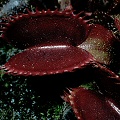
Dionaea 'Red Dragon'
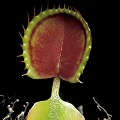
Dionaea 'Cupped Trap'
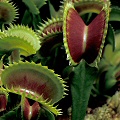
Dionaea 'Dentate Traps'
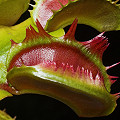
Dionaea 'Fused Tooth'
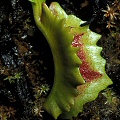
Dionaea 'Wacky Traps'
A: The Venus flytrap is a plant in a monotypic genus. That means there is only one
species of Venus flytrap: Dionaea muscipula. So the short answer is that
there is only one kind of Venus flytrap.
There is more to this, though. Even though there is but one species of Venus flytrap,
horticulturists have developed a number of cultivar Venus flytraps. These are plants with special names attached to them, because they supposedly have special
attributes.
I used to keep a list of all the Dionaea cultivars and
cultivar groups here, but now so many new cultivars are being named, I've given up on this task. Instead,
here's a basic summary of just a few of the cultivars out there....
These are plants which have interesting characters. Some are interesting because
they have nicely colored traps. Others have strange leaf forms. Below I have
listed all the Venus flytrap cultivars that have been officially named and
registered as of the
freshness date of this page. Oh, there are lots of other "named" plants out there,
like "Burbank's Best", "Paradisea" (or some similar variant spelling),
or "Fine-tooth x red", but until these are actually
registered as cultivars I won't list them.
If your plant from the store has some other, odd name like
"Octopus", "Starfish", "Vampire", or similar
drivel, it is just something made up by a bored marketing executive, and has
nothing to do with anything other than marketing. (If it convinced you to buy the plant,
it served its only purpose.)
- Plants with special coloration
- Dionaea 'Clayton's Red Sunset'
- An all-red flytrap with petioles that are always long and skinny, that loses all its leaves during the winter, and that is always entirely red.
- Dionaea 'Green Dragon'
- Often sold as Dionaea 'Red Dragon', the trap margins are green even under intense light. Perhaps a tissue culture mutation of Dionaea 'Red Dragon.'
- Dionaea 'Justina Davis'
- A flytrap with completely green traps, not to be confused with traps that are just pale pink or grown in low light.
- Dionaea 'Red Dragon' (aka Dionaea 'Akai Ryu')
- A dark red plant.
- Plants with trap mutations
- Dionaea 'Cupped Trap'
- The traps are oddly cupped at the tip, and the trap spines are coiled longer in the development process.
- Dionaea 'Dentate Traps'
- The trap spines are modified into short, toothlike triangles. This is known by various incorrect names like dente, dentate, etc.
- Dionaea 'Fused Tooth'
- Although this plant looks normal in the spring, later in the season it produces grotequely malformed leaves where the spines are irregularly merged. Very weird.
- Dionaea 'Jaws'
- The trap spines are short and pointy, the traps are big. It looks quite sharklike when the lobes have just closed!
- Dionaea 'Red Piranha'
- This cultivar has the coloration of Dionaea 'Red Dragon' and the marginal spines of Dionaea 'Dentate Traps'.
- Dionaea 'Sawtooth'
- The trap spines are modified into short, sawtoothed edges.
- Dionaea 'Wacky Traps'
- The leaves are incompletely developed. This is an extremely slow grower that also has strangely distorted flowers. Known in some circles as "Bart Simpson", but this name has not been established and might even violate some trademark laws.
- Dionaea Dentate Traps Group
- A cultivar group, and not a cultivar, this includes all the plants with marginal spines modified into toothlike or sawtooth structures.
- Plants with abnormal trap sizes
- Dionaea 'B52'
- This is a flytrap with very large traps that I registered in my first book; I'm rather proud to see that it is now one of the most widely circulated cultivars in trade. (Note I was not, however, the breeder who developed the plant!)
- Dionaea 'Petite Dragon'
- This cultivar has the coloration of Dionaea 'Red Dragon' but never gets very large. Also, it has bifurcated flower stalks.
- Other types
- There is a neverendingly enlarging list of cultivars--many of which just leave me scratching my head, because I think that the breeders have noticed
some microscopic, largely irrelevant difference that they think makes their plant so special. Fer chrissakes, does EVERYTHING have to have a unique name? I have
seen the collections of Dionaea, in which the grower has strived to collect all the cultivars (I'm looking at you, Damon and Bob!)---and
frankly, I mostly see a lot of plants that all look so damned similar. Oh! Another red plant!
But, there are some other real oddities out there that are interesting. Grow what makes you happy!
Page citations: Anfraix, R. 2004; Bily, G. 2010a, 2010b; Blancquaert, D. 2010; Clayton, C. 2004; D'Amato, P. 1998a; Erbacher, M., & Stoeckl, M. 2005; Gagliardo, R. 1996; Jang, G-W., and Yoon, W.H. 2010; Keehn, R. 2010; Quenon, G. 2008; Read, E. 1999; Rice, B.A. 2000, 2006a; Song, L. 2001a; Srba, M. 2007; Stewart, S. 2004; personal observation.